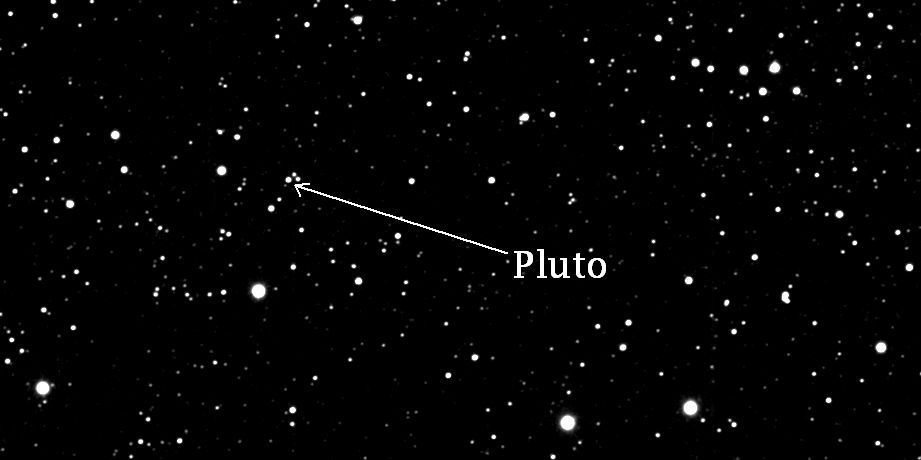
The best way to confirm that you have photographed Pluto is to take two images a couple of days apart, and Pluto will be the object that has moved. You can compare two CCD images taken on June 8 and on June 10 by moving your mouse over the above image, and you will see how far Pluto moved during that period of time. Pluto reached opposition on June 9, 2003. The above images were taken one day before opposition, and one day after opposition.
At the time these images were taken, Pluto was a magnitude 13.8 object. Pluto was the smallest planet in the solar system, until it was officially demoted on August 24, 2006, to the status of a "dwarf planet." Pluto is no longer considered to be a major planet. Pluto differs from the eight major planets in almost every respect. Pluto's orbit is so excentric that it swings inside the orbit of Neptune during a relatively small portion of its 248 year orbit around the sun. Between 1980 and 1999, Pluto was closer to the sun than Neptune. In March 1999, Pluto crossed back over Neptune's orbit and is now more distant than Neptune and will be for more than 200 years until it again swings inside of Neptune's orbit. Pluto's orbit is inclined 17.2 degreees to the ecliptic. Pluto is 4.5 billion kilometers or 2.8 billion miles from the sun at perihelion, and 7.4 billion kilometers or 4.6 billion miles at aphelion. At the time these images were taken, Pluto was as close to Earth as it would be all year long, and was still 29.65 AU away. The light entering the lens of my telescope from which these images were made actually left Pluto 4.11 hours earlier and took that long to reach Earth.
Pluto was discovered in 1930 by Clyde Tombaugh. The search for a ninth planet beyond the orbit of Neptune was inspired by Percival Lowell based upon the mistaken belief that small discrepancies remaining in the orbit of Uranus were caused by another planet. Pluto has a diameter of about 2,300 kilometers, and is smaller than our Moon. Pluto has at least three known moons, the largest of which is named Charon. Charon was discovered in 1978 by Charles Kowal. Pluto rotates once every 6.3872 Earth days, and Charon orbits Pluto with a revolution equal to Pluto's rotational period. Thus, Pluto and Charon present the same face toward each other. Charon's average distance from Pluto is very close -- about 19,640 kilometers. (By comparison, the Moon is 384,000 kilometers from the Earth.).
These images were taken from my backyard in Scottsdale, Arizona. An ST-8E CCD was used on an FCT-150 refractor. On the dates these images were taken, Pluto was in Ophiuchus, near the border with Serpens Cauda.
Constellation: Ophiuchus
RA: 17h 13m 34.6s Dec: -13d 26' 58"
June 8 and 10, 2003
Images by Sid Leach
Scottsdale, Arizona
Recent Images.
Complete list of images.
Description of equipment used to acquire images.
Home
Feedback and comments should go to Sid